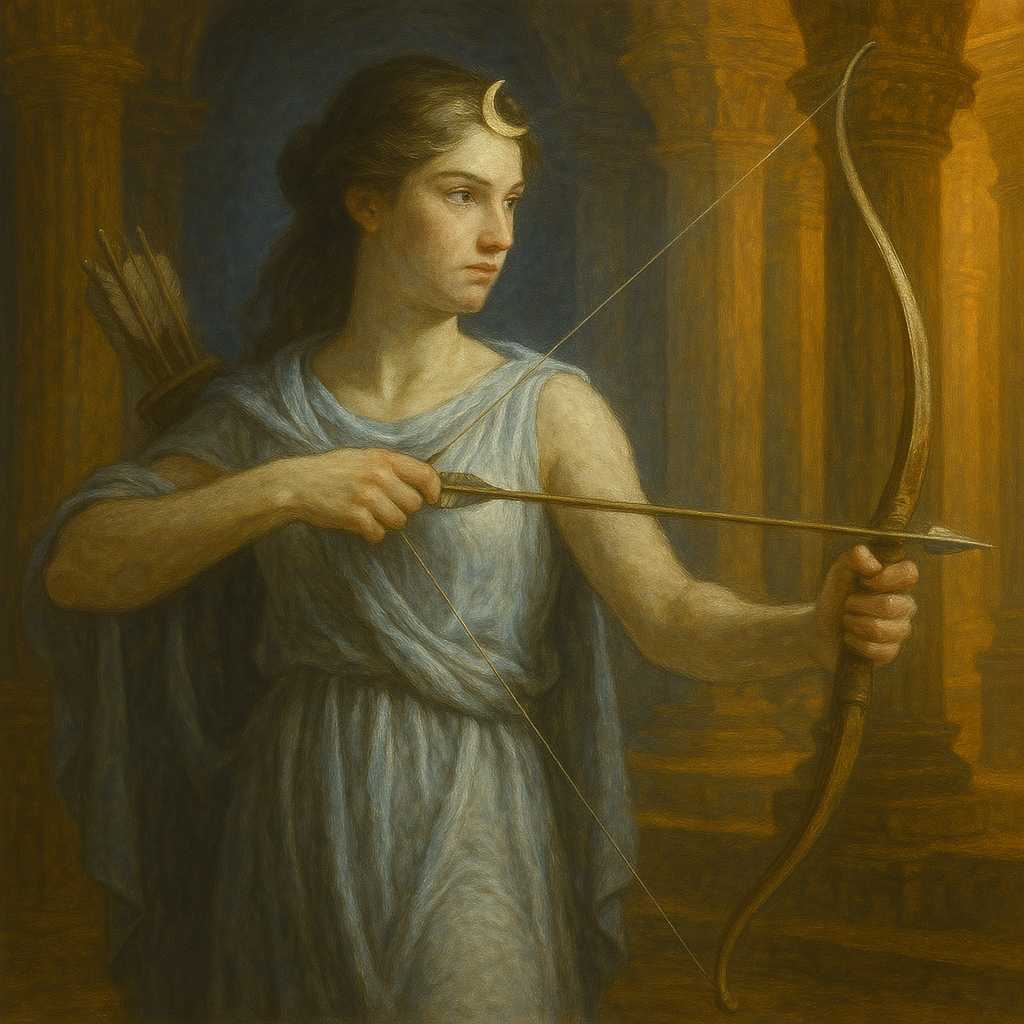Overview
Artemis is the ancient Greek goddess of the moon, the hunt, wild animals, childbirth, and virginity. Revered for her fierce independence and protective nature, she is a powerful symbol of the untamed feminine spirit and the sacred cycles of nature. As the twin sister of Apollo and daughter of Zeus and Leto, Artemis holds a unique position among the Olympian gods as both a maiden goddess and a guardian of life’s thresholds—from birth to death, from wildness to stillness. Her Roman counterpart is Diana.
Origins and Mythological Role
Artemis was born on the island of Delos, shortly before her twin brother, Apollo. In some myths, she helped deliver him, establishing her role as a protector of women in labor. She is often associated with liminal spaces—edges of the forest, twilight, the crescent moon—where the divine and wild intermingle.
From an early age, Artemis is portrayed as independent, fierce, and free. She asked her father Zeus to remain unmarried and was granted eternal maidenhood, making her a patron of virgins, young girls, and those who seek solitude and self-sovereignty.
Symbols and Iconography
Artemis is often depicted as a young, athletic huntress, robed in a short tunic, with a bow and quiver slung across her back. She is surrounded by the forest, accompanied by deer, hounds, or nymphs.
Common Symbols
- Crescent Moon – Symbol of feminine intuition, cycles, and lunar power
- Bow and Arrows – Representing skill, precision, and focus
- Deer or Stag – Sacred animal representing gentleness, instinct, and connection to the wild
- Hunting Dogs – Loyalty, protection, and divine pursuit
- Cypress Tree – Associated with mourning, transformation, and the sacred grove
As a moon goddess, Artemis is also connected to Selene, the personification of the moon, and shares aspects of lunar mystery, emotional depth, and intuition.
Attributes and Powers
1. Goddess of the Hunt and the Wilderness
Artemis roams the forests and mountains, armed with her bow, embodying the wild, primal connection to nature. She represents survival, self-sufficiency, and the sacredness of the natural world.
2. Guardian of the Moon and Cycles
In later mythology, Artemis becomes closely identified with the moon, especially its waxing and waning phases. She embodies the rhythmic cycles of life, intuition, and the feminine mysteries.
3. Patroness of Maidenhood and Purity
Artemis is a virgin goddess who chooses solitude and chastity, not as repression, but as empowered self-direction. She watches over young women, helping them transition into their power.
4. Protector of Women and Children
As a goddess of childbirth and midwifery, Artemis safeguards pregnant women, infants, and the vulnerable. She is called upon for healing, safe delivery, and defense during times of transition.
5. Avenger of Injustice and Boundary Violation
Artemis is swift to punish those who violate sacred boundaries, especially related to women, animals, and nature. Her fierce side ensures respect for autonomy and the sacred.
Key Myths and Stories
Birth of Apollo
Artemis is born first, then assists in the birth of her twin brother, Apollo, demonstrating her connection to midwifery and female strength even as a child.
Actaeon’s Punishment
A hunter named Actaeon stumbles upon Artemis bathing. As a violation of her privacy and sanctity, she transforms him into a stag, and he is torn apart by his own hounds—illustrating her power to enforce sacred boundaries.
The Death of Orion
There are several versions of this myth, but in many, Artemis kills Orion, a giant hunter, either to protect her independence, punish hubris, or honor divine law. Some say she places him in the stars as a constellation, showing her duality as both protector and destroyer.
Temples and Worship
Ephesus – Temple of Artemis
One of the Seven Wonders of the Ancient World, the Temple of Artemis at Ephesus was a grand site of devotion, blending aspects of Artemis with local fertility goddesses. It drew pilgrims from across the Mediterranean.
Other Sacred Sites
- Delos – Her mythic birthplace and site of early worship
- Brauron (Attica) – A sanctuary where young girls performed rituals and rites of passage to honor Artemis
Festivals
- Artemisia – Celebrated in various regions with hunting contests, dances, and offerings
- Brauronia – A rite of passage for girls transitioning into adolescence
- Full Moon Rituals – In later spiritual traditions, Artemis is honored during the full moon as a guardian of intuition and empowerment
Spiritual and Archetypal Significance
Artemis continues to resonate in spiritual, feminist, and psychological traditions as:
- The Wild Woman Archetype – Independent, fierce, in tune with instinct and nature
- Lunar Guardian – Embodying emotional wisdom, intuition, and cycles
- Protector of Boundaries – Teaching the importance of personal space, integrity, and self-respect
- Guide for Women and Youth – Empowering individuals to embrace strength, sovereignty, and inner truth
- Symbol of Sacred Solitude and Purpose – Inviting a path of clarity, intention, and self-honoring
Practitioners may invoke Artemis for:
- Empowerment and protection in times of transition
- Reconnecting with the moon, nature, and feminine wisdom
- Healing emotional wounds related to boundaries and autonomy
- Rites of passage, especially for young women or those reclaiming their strength
Conclusion
Artemis, goddess of the moon and the untamed forest, teaches us the power of intuition, sovereignty, and sacred protection. She reminds us to honor the natural rhythms of life, to protect what is vulnerable, and to stand in our truth without apology. As a beacon of strength and stillness, wildness and wisdom, Artemis offers a timeless guide to living in harmony with nature, the moon, and the fierce spirit within.

